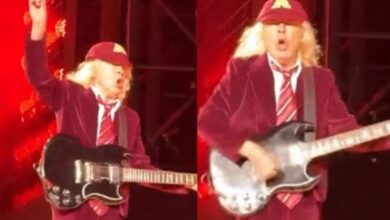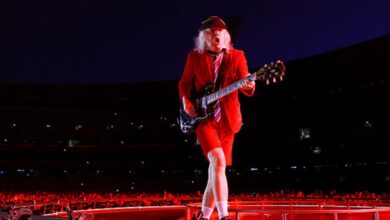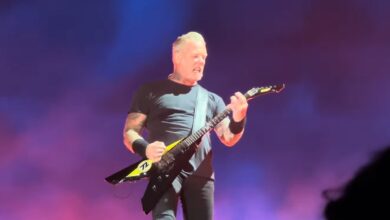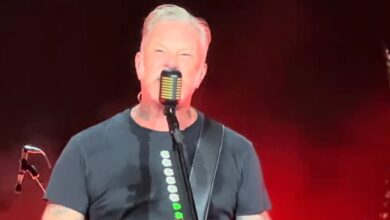AC/DC Turned Melbourne Into a Storm: The Rain-Soaked “Thunderstruck” of November 16, 2025
AC/DC’s second night at the MCG on 16 November 2025 didn’t feel like a simple continuation of the tour—it felt like Melbourne reclaiming its place as one of the true homes of rock. From late afternoon onward, waves of fans wearing black shirts and flashing red devil horns streamed out of Richmond Station, creating an almost festival-like march toward the stadium. By sunset, more than 80,000 people had filled the stands and grass areas, buzzing with anticipation and comparing stories about how the previous night had reportedly shaken the city with crowd movement alone.
Inside the stadium, the sheer scale of the production bordered on surreal. Giant video screens stretched across the stage, flanked by towering lighting rigs and silhouettes of cannons foreshadowing what fans knew would come later. As Amyl and the Sniffers fired through their opening set, the crowd’s chants of “AC-DC! AC-DC!” echoed off the walls. For longtime Melburnians, the moment was doubly emotional—AC/DC had emerged from this city half a century earlier, and now they were returning to ignite the MCG once again.
When the house lights dropped at exactly 8:30 PM, the sound of the crowd merged into a single explosive roar. A fiery red-and-gold intro sequence flashed across the LED screens, pulsing like a voltage surge, and when the band finally tore into “If You Want Blood (You’ve Got It),” the stadium erupted. Brian Johnson strode onstage with unmistakable swagger, Angus Young duckwalking in tight circles as if no years had passed since the band’s earliest tours.
The opening run of songs hit with relentless force. “Back in Black” rattled the stands as tens of thousands belted out the chorus. “Demon Fire” and “Shot Down in Flames” blended old-school grit with modern polish, showing the band’s ability to bridge generations without ever losing their bite. With every crowd shot on the giant screens, the diversity of fans stood out—parents lifting children onto their shoulders, teenagers in brand-new tour shirts, and older fans mouthing lyrics that had been a soundtrack to their youth.
Five songs into the set, the lighting suddenly shifted into sharp flashes of blue and white. The moment Angus struck the first lightning-fast notes of “Thunderstruck,” the crowd reacted as if jolted by electricity. A deafening scream rolled through the stadium as 80,000 voices clapped in rapid rhythm, chanting “Thunder! Thunder!” in unison. The massive screens zoomed in on Angus’s fingers as they danced across the fretboard, turning the iconic intro into a ritual shared between band and audience.
The ground beneath fans’ feet seemed to tremble as the chorus hit, and whether or not actual seismic readings occurred, the physical energy felt unmistakably intense. Entire sections of the stadium jumped simultaneously, creating visible shockwaves of movement. Every time Brian shouted, “You’ve been… THUNDERSTRUCK!” the roar came back at him like a living wall of sound.
Brian Johnson’s vocals carried surprising force, especially considering his age and the decades he has spent battling through some of the loudest shows in rock history. His signature rasp cut through the mix with clarity and bite. Fans who had worried he might struggle found themselves grinning at how powerfully he delivered each line, proving that experience can sometimes sharpen rather than dull a performer’s edge.
The middle section of the song became a massive call-and-response moment. Angus ventured down the runway-shaped stage extension, duckwalking with wild intensity, dropping to his knees, and leaning into the crowd as they sang back every riff and melody. Cameras cut to emotional faces—some screaming, some laughing, some simply stunned at witnessing this legendary moment unfold live.
The production around “Thunderstruck” elevated the performance even further. Sheets of white pyro ignited with each chorus, while sweeping spotlights painted the crowd in moving patterns. Thousands of glowing devil horns blinked in rhythm, creating the illusion of a single organism pulsing with the music. For several minutes, the boundaries of the stadium seemed to disappear, replaced by a shared electric atmosphere that felt almost cinematic.
In the quieter breakdown, the crowd became part of the instrumentation. Tens of thousands clapped slightly off-beat yet collectively created a thunderous rhythm of their own. Brian walked along the front edge of the stage, smiling with open pride as the audience carried the melody. For a moment, the band simply stood and let the crowd’s voice take over, honoring the song’s decades-long legacy.
When the final chord of “Thunderstruck” rang out, the reaction was instantaneous. Fans screamed, hugged strangers, and tossed empty cups into the air like confetti. Even security guards, usually stoic, cracked smiles at the sheer joy radiating across the venue. The first Melbourne show had been powerful, but night two felt like the confirmation of a citywide celebration—AC/DC had returned, and they were louder than ever.
The band wasted no time before launching into “Have a Drink on Me” and “Hells Bells,” with the massive bronze bell descending from above as if summoning the ghosts of rock history. The mid-set run of classics—“Highway to Hell,” “Shoot to Thrill,” and others—created a seamless blend of eras, each song hitting like a reminder of how many anthems AC/DC has gifted to the world.
One of the night’s surprise highlights was “Jailbreak,” a Bon Scott-era gem recently revived for the tour. Many fans had only dreamed of hearing it live, and when Angus hit the first riff, the reaction bordered on disbelief. Older fans wiped their eyes, younger ones jumped with excitement, and the entire stadium recognized that they were witnessing a rarity brought back for a special moment in the band’s history.
As the show pushed into its final stretch with “Whole Lotta Rosie” and a fiery, extended “Let There Be Rock,” both band and audience appeared to run on pure adrenaline. Angus turned his solo into a marathon, sprinting, spinning, collapsing backward, and never missing a note. In the stands, fans rested hands on their knees between songs, gasping for breath before rising again the moment the next riff kicked in.
The encore—“T.N.T.” followed by “For Those About to Rock (We Salute You)”—felt like a final explosion. Cannons fired in sync with the chorus, fireworks burst over the stadium roof, and the crowd reacted as if witnessing a historic finale. The punch of each blast reverberated through the chest, matching the emotional weight of the lyrics echoing across Melbourne’s most iconic sporting ground.
Even after the band bowed and the lights came up, the essence of “Thunderstruck” lingered in the air. As thousands streamed out along Brunton Avenue, echoes of the riff drifted from phone speakers, groups shouted the “Thunder!” refrain into the night, and fans replayed shaky videos they had just recorded. This wasn’t just another concert; for Melbourne, it instantly became one of those “I was there” nights—an evening when AC/DC shook the city all over again.
Related :





